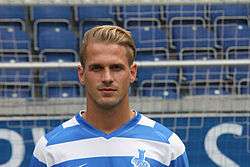1. FC Union Berlin
 | ||||
| Full name | 1. FC Union Berlin e. V. | |||
|---|---|---|---|---|
| Nickname(s) | Die Eisernen (The Iron Ones) | |||
| Founded |
1906 (refounded 1966) | |||
| Ground | Stadion An der Alten Försterei | |||
| Capacity | 22,012 | |||
| Chairman | Dirk Zingler | |||
| Manager | Jens Keller | |||
| League | 2. Bundesliga | |||
| 2016–17 | 2. Bundesliga, 4th | |||
| Website | Club website | |||
|
| ||||
1. FC Union Berlin is a professional German association football club based in Berlin. The club emerged under the current name in 1966 but can be traced back to 1906, when predecessor FC Olympia Oberschöneweide was founded. They have competed in the 2. Bundesliga for seven consecutive seasons.
The home ground Stadion An der Alten Försterei (Stadium by the old forester's house) is the largest single-purpose football stadium in the German capital. It has been home to Union Berlin and its forerunners since it was opened in 1920.[1] The stadium became internationally famous for concerts and events like the annual Weihnachtssingen (Christmas Carols Event) and the WM-Wohnzimmer (World Cup Living Room) in 2014.[2]
The club is well known for its enthusiastic and creative fan base and for its chant "Eisern Union" (Iron Union).[3]
History
First foundation (1906–1945)
The name 1. FC Union Berlin was used by two football clubs that shared a common origin as FC Olympia 06 Oberschöneweide, founded in 1906 in the Oberschöneweide district of Berlin. The side took on the name SC Union 06 Oberschöneweide in 1910. Union was one of Berlin's premier clubs in the interwar period, regularly winning local championships and competing at the national level, including an appearance in the 1923 German championship final which they lost 0–3 to Hamburger SV.
Early on the team was nicknamed "Schlosserjungs" (English: metalworker-boys), because of their then all blue kit, reminiscent of the typical work clothing worn in the factories of the industrial Oberschöneweide district. The popular cry of Union-supporters – "Eisern Union!" (Iron Union) – also emerged at this time. Since its foundation the club had a clearly working-class image in contrast to other local clubs with middle-class origins, such as Viktoria 89 Berlin, Blau-Weiß 90 Berlin, BSV 92 Berlin or Tennis Borussia Berlin.
In 1933, German football was reorganized under the Third Reich into 16 top flight divisions known as Gauligen. Oberschöneweide became part of the Gauliga Berlin-Brandenburg where they generally earned middling results. They were relegated in 1935 and returned to first division play in 1936 after only one season's absence. In 1940, the team finished first in Group B of the division and then defeated Blau-Weiss (1–2, 3–0) to win the overall division title. That advanced the club to the national playoffs where they were put out by Rapid Wien in the opening group round (2–3, 1–3). Union resumed its place as an unremarkable side. They were relegated again in 1942 and played the final war-shortened Gauliga season in 1944–45.
Dissolution and split up (1945–1961)
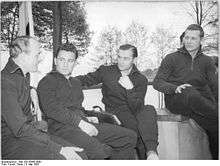
After World War II, occupying Allied authorities ordered the dissolution of all organizations in Germany, including sports and football associations. A new Municipal Sports Group called SG Oberschöneweide was formed in late 1945 and it played in the City League organized immediately after the war which had four regional departments. The team did not qualify to the newly created Oberliga Berlin (I) in 1946 after a poor season, but was promoted in 1947, won the division title right away and regained club status as SG Union 06 Oberschöneweide during 1948–49.
The club finished the 1949–50 season in second place in Berlin and qualified to take part in the national final rounds. However, escalating Cold War tensions led Soviet authorities to refuse the team permission to travel to take part. Two Union teams then emerged as most players and coaches fled to the west to form Sport-Club Union 06 Berlin which took part in the scheduled playoff match in Kiel against Hamburger SV, losing 0:7.[4][5]
The players remaining in the east carried on as Union Oberschöneweide while a number of players who had fled to the west to form SC organized a third side called Berliner Ballspiel-Club Südost. The western team was a strong side until the construction of the Berlin Wall in 1961, drawing huge crowds to matches in the Olympiastadion. The division of the city led to a change of fortunes for the club which plays today in the lower divisions before meager crowds.
Restart as Union Berlin (1961–1990)

The eastern branch of the club went through a number of name changes: Union Oberschöneweide (1950), BSG Motor Oberschöneweide (1951), SC Motor Berlin (1955), TSC Oberschöneweide (1957), TSC Berlin (1963) – finally becoming the football club 1. FC Union Berlin in 1966. They developed a bitter rivalry with Stasi-sponsored Dynamo Berlin. While their arch rivals won 10 titles in a row in highly dubious circumstances, Union yo-yoed between the Oberliga and the DDR-Liga with very little success, largely due to the East German's government policy of favouring 'elite' clubs at the expense of 'civilian' clubs like Union. Union managed to win the East German Cup in 1968 when they defeated FC Carl Zeiss Jena 2:1 although they lost in their second cup appearance in 1986 to 1. FC Lokomotive Leipzig by a score of 1:5.
2. Bundesliga era (1990–present)
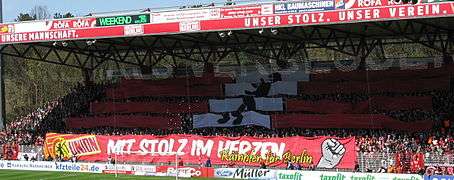
After German reunification in 1990, the team continued to perform well on the field, but almost collapsed financially. They managed to hang on through some tight times and find sponsorship, but only after winning their division in both 1993 and 1994 and each time being denied a license to play in the 2. Bundesliga due to their financial problems. The club had another close brush with financial failure in 1997.
Union again came close to advancing to 2.Bundesliga in 1998–99 and 1999–2000, but were disappointed. They were finally successful in 2000–01, under Bulgarian manager Georgi Vasilev, easily winning the Regionalliga Nord (III) and moving up a division to become the city's second most popular side. That same year they appeared in the final of the German Cup where they lost 0–2 to FC Schalke 04, and advanced as far as the second round in UEFA Cup before being put out by Bulgarian side PFC Litex Lovech. The club slipped to the Regionalliga Nord (III) in 2004–05 and then to the NOFV-Oberliga Nord (IV) in 2005–06, but has returned to third division play after capturing the Oberliga title. In 2008–09, Union became one of the founding clubs of the new 3. Liga, and its inaugural champion, securing first place and promotion to the 2. Bundesliga on 10 May.
Stadium

In 1920 SC Union Oberschöneweide (forerunner of today's 1. FC Union Berlin) had to find a new home ground as its former pitch had been built over by developers with residential buildings. The club moved a little further away from the city to the north-western part of the borough of Köpenick. The new stadium was officially opened in August 1920 with a match between Oberschöneweide and the then German champions 1. FC Nuremberg (1:2). The inaugural match in at the Alte Försterei had already been played on 17 March, when Union challenged Viktoria 89 Berlin.
When Union won promotion to the DDR-Oberliga (the top flight in East Germany) in 1966, the stadium soon needed to be expanded. The ground was first expanded in 1970 when the Gegengerade terrace was raised, whilst further extensions to the terracing at both ends in the late 1970s and early 1980s increased the capacity furthermore to 22,500. However, the somewhat spartan facilities at Alte Försterei had quickly begun to show their age and went into a serious decline.

After German reunification, when Union were assigned by the German Football Association to play in the 3rd league, the outdated stadium proved only one of a number of factors that hampered the club's push for promotion to higher leagues.
In the middle of 2008, the club decided to finally modernise the stadium, the Stadion An der Alten Försterei (Old Forester's House). Money was still tight, and so the fans simply built the ground themselves. More than 2,000 Union supporters invested 140,000 working hours to create what is now regarded as the largest football-only stadium in Berlin.[6] Inside the stadium an array of outside beer kiosks and open air grills serving bratwurst and pork steaks at the back of the stand provide the culinary staples. The official opening on 12 July 2013, was celebrated with a friendly against Scottish Champions Celtic F.C.. It holds 22,012 people with 3,617 seats. The rest is terracing.
World Cup Living Room
In 2014, the club came up with the idea of inviting fans to take their own sofas to the ground for the whole of the World Cup.[7] More than 800 sofas were placed on the pitch in rows in front of the big screen.[8] The event was later recognized with the Fan Experience Award at The Stadium Business Summit 2015 in Barcelona.[9]
Organization
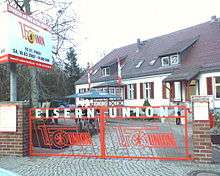
1. FC Union Berlin is led mostly by former fans. Since 2004, Dirk Zingler serves as the club's president,[10] following Jürgen Schlebrowski who had been in office from 2003 to 2004. The club had 11.000 registered members in 2013.[11]
| President | From | To |
|---|---|---|
| Gerhard Kalweit | 5. June 1990 | July 1993 |
| Detlef Bracht | 17. August 1993 | July 1994 |
| Horst Kahstein | 14. November 1994 | September 1997 |
| Heiner Bertram | 7. October 1997 | 12. October 2003 |
| Jürgen Schlebrowski | 13. October 2003 | 30. June 2004 |
| Dirk Zingler | 1. July 2004 |
Sponsorships
In 2014 1. FC Union Berlin was sponsored by 301 private and corporate partners.
| Period | Kit manufacturer | Shirt sponsor |
|---|---|---|
| 2005/06 | Nike | EastWest |
| 2006/07 | ||
| 2007/08 | Silicon Sensor | |
| 2008/09 | do you football | |
| 2009/10 | kfzteile24 | |
| 2010/11 | ||
| 2011/12 | Uhlsport | |
| 2012/13 | f.becker | |
| 2013/14 | ||
| 2014/15 | kfzteile24 | |
| 2015/16 | Macron | |
| 2016/17 | Layenberger |
Honours
Domestic
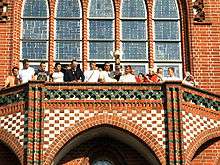
- German Championship
- Runners-up: 1923
- FDGB-Pokal:
- Winners: 1968
- Runners-up: 1986
- DFB-Pokal:
- Runners-up: 2001
- 3. Fußball-Liga:
- Winners: 2009
- Brandenburg football champions: 2
- Winners: 1920, 1923
- Gauliga Berlin-Brandenburg:
- Winners: 1940
- Oberliga Berlin (1945–63):
- Winners: 1948
- Berlin Cup:
- Winners: 1947, 1948, 1994, 2007, 2009
European
Seasons

Players
Current squad
- As of 1 July 2017 [12]
Note: Flags indicate national team as defined under FIFA eligibility rules. Players may hold more than one non-FIFA nationality.
|
|
Notable players
Reserve team
The club's reserve team, 1. FC Union Berlin II, most recently played in the tier four Regionalliga Nordost, having won promotion to the league in 2012. Previous to this it spent two seasons in the NOFV-Oberliga Nord. At the end of the 2014–15 season the club withdrew the team from competition.[13][14]
Coaches
| List of Union Berlin Managers since 1965 | ||||||||||||||||||||||||||||||||||||||||||||||||||||||||||||||||||||||||||||||||||||||||||||||||||||||||||||||||||
|---|---|---|---|---|---|---|---|---|---|---|---|---|---|---|---|---|---|---|---|---|---|---|---|---|---|---|---|---|---|---|---|---|---|---|---|---|---|---|---|---|---|---|---|---|---|---|---|---|---|---|---|---|---|---|---|---|---|---|---|---|---|---|---|---|---|---|---|---|---|---|---|---|---|---|---|---|---|---|---|---|---|---|---|---|---|---|---|---|---|---|---|---|---|---|---|---|---|---|---|---|---|---|---|---|---|---|---|---|---|---|---|---|---|---|
.jpg) Uwe Neuhaus was the longest serving manager of 1. FC Union Berlin.
| ||||||||||||||||||||||||||||||||||||||||||||||||||||||||||||||||||||||||||||||||||||||||||||||||||||||||||||||||||
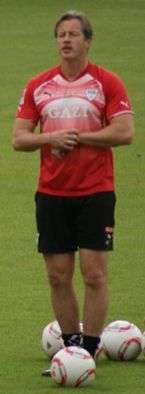
| Name | 1. FC Union Berlin | |
|---|---|---|
| since | to | |
| Georgi Vasilev | 1. Jul. 1999 | 12. Oct. 2002 |
| Ivan Tischanski | 13. Oct. 2002 | 5. Nov. 2002 |
| Miroslav Votava | 6. Nov. 2002 | 24. Mar. 2004 |
| Aleksandar Ristić | 25. Mar. 2004 | 30. Jun. 2004 |
| Frank Wormuth | 1. Jul. 2004 | 27. Sep. 2004 |
| Werner Voigt | 28. Sep. 2004 | 9. Dec. 2004 |
| Lothar Hamann/Holger Wortmann | 10. Dec. 2004 | 19. Dec. 2004 |
| Frank Lieberam | 20. Dec. 2004 | 9. Dec. 2005 |
| Georgi Vasilev | 13. Dec. 2005 | 5. Apr. 2006 |
| Christian Schreier | 6. Apr. 2006 | 19. Jun. 2007 |
| Uwe Neuhaus | 20. Jun. 2007 | 12. May 2014 |
| Norbert Düwel | 1. Jul. 2014 | 31. Aug. 2015 |
| Sascha Lewandowski | 1. Sep. 2015 | 4. Mar. 2016 |
| André Hofschneider | 5. Mar. 2016 | 30. Jun. 2016 |
| Jens Keller | 1. Jul. 2016 | 30. Jun. 2018 |
European record
Overview
| Competition | S | P | W | D | L | GF | GA | GD |
|---|---|---|---|---|---|---|---|---|
| UEFA Europa League/UEFA Cup | 1 | 4 | 1 | 2 | 1 | 4 | 3 | +1 |
| Total | 1 | 4 | 1 | 2 | 1 | 4 | 3 | +1 |
Matches
| Season | Competition | Round | Opponent | Home | Away | Aggregate |
|---|---|---|---|---|---|---|
| 2001–02 | UEFA Cup | 1R | |
3–0 | 1–1 | 4–1 |
| 2R | |
0–2 | 0–0 | 0–2 | ||
Club culture
1. FC Union Berlin is recognized as one of Europe's cult clubs, based on many unique fan and club initiatives over the last two decades.[15][16][17]
The nicknames of the club are Eiserne (The Iron Ones) or Eisern Union (Iron Union), both of which are used to refer to the club from Berlin. Their nicknames evolved from the earlier sobriquet Schlosserjungs (metalworker boys), which was in reference to the blue kit the Union played in, as it was reminiscent of the overalls worn by local workers.[18]
In former GDR times Union was known for a rivalry with Dynamo Berlin who was affiliated with East Germany's Secret Service Stasi. Union was patronized by Eastern German Trade Union FDGB. The club played some identificatory role in the unofficial opposition against the authorities of the communist system.[19]
In May 2004, the supporters raised enough money to secure the club's license for fourth-division football through a campaign called 'Bleed for Union'.[20] This catchphrase was not meant metaphorically. One element of the campaign was that fans donated blood to Berlin hospitals and then gave the money they received from the blood bank to their club.
After 2010 Union Berlin became increasingly attractive for new Berliners, even internationals, who were drawn to the atmosphere at the club.[21]
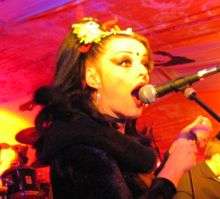 Punk legend Nina Hagen
Punk legend Nina Hagen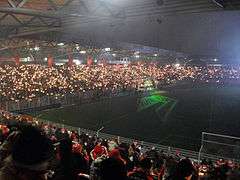 Weihnachtssingen (Christmas carols singing) in 2010
Weihnachtssingen (Christmas carols singing) in 2010- Union Berlin boat on the river Spree
 Union Berlin Bus
Union Berlin Bus
Songs
The official Union Berlin song is "Eisern Union" by the famous German punk-star Nina Hagen.[22] The composition was recorded in 1998. Four versions were issued on a CD single by G.I.B Music and Distribution GmbH.
The famous supporters' chant 'Eisern Union' (Iron Union) bounces back and forth between the terraces named Waldseite and the Gegengerade and is followed by mutual acknowledging applause.[23]
Christmas tradition
Union Berlin is also well known for its Christmas traditions celebrated in their home stadium.[24] In 2003 the yearly Union Weihnachtssingen started as an unofficial gathering to which just 89 fans showed up. In 2013, 27,500 people attended, including players and supporters of other teams from around Germany and Europe. Fans drink Glühwein (mulled wine), wave candles around, light flares and sing a combination of Christmas carols and football chants.[25]
Mascot
Ritter Keule (Literally: Cudgel the Knight) is the mascot of Union Berlin.[26] He was first introduced in 2000.[27]
Movies and games
Union fürs Leben (Union for life) is a 2014 documentary film that showcases the supporters passion for 1. FC Union Berlin.[28] Union Berlin is also part of the popular FIFA 16, an association football simulation video game.[29]
See also
References
- ↑ STADIUM AT THE OLD FORESTER’S HOUSE, Retrieved 5 March 2016.
- ↑ Stadion An der Alten Försterei, Football Tripper, Retrieved 5 March 2016.
- ↑ Bundesliga and beyond – Union Berlin, Retrieved 5 March 2016.
- ↑ Ein Spiel für Verein und Flüchtlinge (in German) Berliner Zeitung, published: 4 January 2015, accessed: 18 November 2015
- ↑ SC Union 06: Die Erben der Schlosserjungs (in German) Der Tagesspiegel, published: 25 June 2012, accessed: 18 November 2015
- ↑ The Twelfth Man, Retrieved 5 March 2016.
- ↑ "A Tiny Berlin Soccer Stadium Is The Best Place In The World To Watch The World Cup". Business Insider. Retrieved 5 March 2016.
- ↑ "The secret police with its own football team". BBC. Retrieved 5 March 2016.
- ↑ THE STADIUM BUSINESS AWARDS 2015, Retrieved 5 March 2016.
- ↑ Dirk Zingler, Retrieved 5 March 2016.
- ↑ 11 Freunde cover story translation: FC Union Berlin – An example for all to follow?, Union in English, Retrieved 5 March 2016.
- ↑ "Profis Saison 2016/17" (in German). 1. FC Union Berlin. Retrieved 17 November 2015.
- ↑ Das deutsche Fußball-Archiv (in German) Historical German domestic league tables, Retrieved 5 March 2016.
- ↑ 1. FC Union Berlin II at Fussball.de (in German) Tables and results of all German football leagues, Retrieved 5 March 2016.
- ↑ Union Berlin fans celebrate club's 50th birthday in style, ESPN, Retrieved 5 March 2016.
- ↑ Six Clubs You Have To Visit Before You Die, Copa90 Channel, Retrieved 8 March 2016.
- ↑ Sausages and Caviar Football Magazine – 1.FC Union Berlin, Sausage and Caviar, Retrieved 24 March 2016.
- ↑ 7 Things You Need To Know About Union Berlin, Retrieved 5 March 2016.
- ↑ K. Farin/H. Hauswald: Die dritte Halbzeit, 1993, p. 5–14.
- ↑ “I’ve given my blood for Union”, Retrieved 5 March 2016.
- ↑ The Fans Who Literally Built Their Club – Union Berlin, Copa90 Channel, Retrieved 24 March 2016.
- ↑ Eisern Union Chords by Nina Hagen, Ultimate Guitar, Retrieved 5 March 2016.
- ↑ 1.FC Union Berlin: Our love, our team, our pride, our club, Retrieved 5 March 2016.
- ↑ FC Union Berlin: a remarkable club with their very own Christmas tradition, Retrieved 5 March 2016.
- ↑ Watch 27,000 Union Berlin football fans gather in stadium to sing Christmas carols, Mirror, Retrieved 24 March 2016.
- ↑ Union Berlin Training, Retrieved 16 March 2016.
- ↑ Ritter Keule Steckbrief, Retrieved 16 March 2016.
- ↑ Union fürs Leben, Retrieved 16 March 2016.
- ↑ Union Berlin, Futhead, Retrieved 16 March 2016.
External links
| Wikimedia Commons has media related to 1. FC Union Berlin. |
- Official website
- Union Forum – Fan Forum in German and English
- Abseits Guide to German Soccer
- Fan website in English
.jpg)
